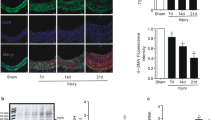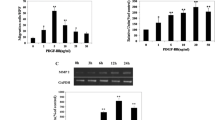Abstract
CTRP3/cartducin, a novel secretory protein, is a member of the C1q and tumor necrosis factor (TNF)-related protein (CTRP) superfamily. CTRP3/cartducin gene is transiently up-regulated in a balloon-injured rat carotid artery tissue. In this study, we report a new function of CTRP3/cartducin as a regulator of angiogenic processes. CTRP3/cartducin promoted proliferation and migration of mouse endothelial MSS31 cells in a dose-dependent manner. Further, stimulation of MSS31 by CTRP3/cartducin led to activation of extracellular signal-regulated kinase 1/2 (ERK1/2) and p38 mitogen-activated protein kinase (MAPK). MAPK/ERK kinase 1/2 (MEK1/2) inhibitor, U0126, and p38 MAPK inhibitor, SB203580, blocked the CTRP3/cartducin-induced cell proliferation, and migration was blocked by U0126, but not the SB203580. Taken together, these results suggest that CTRP3/cartducin may be involved as a novel angiogenic factor in the formation of neointima following angioplasty.





Similar content being viewed by others
References
Kishore U, Gaboriaud C, Waters P et al (2004) C1q and tumor necrosis factor superfamily: modularity and versatility. Trends Immunol 25:551–561
Wong GW, Wang J, Hug C et al (2004) A family of Acrp30/adiponectin structural and functional paralogs. Proc Natl Acad Sci USA 101:10302–10307
Lasser G, Guchhait P, Ellsworth JL et al (2006) C1qTNF-related protein-1 (CTRP-1): a vascular wall protein that inhibits collagen-induced platelet aggregation by blocking VWF binding to collagen. Blood 107:423–430
Mandal MN, Vasireddy V, Reddy GB et al (2006) CTRP5 is a membrane-associated and secretory protein in the RPE and ciliary body and the S163R mutation of CTRP5 impairs its secretion. Invest Opthal Vis Sci 47:5505–5513
Maeda T, Abe M, Kurisu K et al (2001) Molecular cloning and characterization of a novel gene, CORS26, encoding a putative secretory protein and its possible involvement in skeletal development. J Biol Chem 276:3628–3634
Maeda T, Jikko A, Abe M et al (2006) Cartducin, a paralog of Acrp30/adiponectin is induced during chondrogenic differentiation and promotes proliferation of chondrogenic precursors and chondrocytes. J Cell Physiol 206:537–544
Akiyama H, Furukawa S, Wakisaka S et al (2006) Cartducin stimulates mesenchymal chondroprogenitor cell proliferation through both extracellular signal-regulated kinase and phosphatidylinositol 3-kinase/Akt pathways. FEBS J 273:2257–2263
Li JM, Zhang X, Nelson PR et al (2007) Temporal evolution of gene expression in rat carotid artery following balloon angioplasty. J Cell Biochem 101:399–410
Farb A, Kolodgie FD, Hwang JY et al (2004) Extracellular matrix changes in stented human coronary arteries. Circulation 110:940–947
Khurana R, Simons M, Martin JF et al (2005) Role of angiogenesis in cardiovascular disease. Circulation 112:1813–1824
Pels K, Labinaz M, Hoffert C et al (1999) Adventitial angiogenesis early after coronary angioplasty: correlation with arterial remodeling. Arterioscler Thromb Vasc Biol 19:229–238
Bussolino F, Mantovani A, Persico G (1997) Molecular mechanisms of blood vessel formation. Trends Biochem Sci 22:251–256
Yanai N, Satoh T, Obinata M (1991) Endothelial cell create a hematopoietic inductive microenvironment preferential to erythropoiesis in the mouse spleen. Cell Struct Funct 16:87–93
Tanaka K, Abe M, Sato Y (1999) Roles of extracellular signal-regulated kinase 1/2 and p38 mitogen-activated protein kinase in the signal transduction of basic fibroblast growth factor in endothelial cells during angiogenesis. Jpn J Cancer Res 90:647–654
Yamauchi T, Kamon J, Ito Y et al (2003) Cloning of adiponectin receptors that mediate antidiabetic metabolic effects. Nature 423:762–769
Liotta LA, Kohn EC (2001) The microenvironment of the tumor-host interface. Nature 411:375–379
Shono T, Kanetake H, Kanda S (2001) The role of mitogen-activated protein kinase activation within focal adhesion in chemotaxis toward FGF-2 by murine brain capillary endothelial cells. Exp Cell Res 264:275–283
Liu F, Verin AD, Wang P et al (2001) Differential regulation of sphingosine-1-phosphate- and VEGF-induced endothelial chemotaxis. Involvement of G(1alpha2)-linked Rho kinase activity. Am J Respir Cell Mol Biol 24:711–719
Rousseau S, Houle F, Kotanides H et al (2000) Vascular endothelial growth factor (VEGF)-driven actin-based motility is mediated by VEGFR2 and requires concerted activation of stress-activated protein kinase 2 (SAPK2/p38) and geldanamycin-sensitive phosphorylation of focal adhesion kinase. J Biol Chem 275:10661–10672
Arefieva TI, Kukhtina NB, Antonova OA et al (2005) MCP-1-stimulated chemotaxis of monocytic and endothelial cell is dependent on activation of different signaling cascades. Cytokine 31:439–446
Tong Q, Zheng L, Li B et al (2006) Hypoxia-induced mitogenic factor enhances angiogenesis by promoting proliferation and migration of endothelial cells. Exp Cell Res 312:3559–3569
Acknowledgements
This work was supported by Grants-in-aid for Scientific Research (No. 18592062) and the 21st Century Center of Excellence Program from the Ministry of Education, Culture, Sports, Science and Technology of Japan.
Author information
Authors and Affiliations
Corresponding author
Rights and permissions
About this article
Cite this article
Akiyama, H., Furukawa, S., Wakisaka, S. et al. CTRP3/cartducin promotes proliferation and migration of endothelial cells. Mol Cell Biochem 304, 243–248 (2007). https://doi.org/10.1007/s11010-007-9506-6
Received:
Accepted:
Published:
Issue Date:
DOI: https://doi.org/10.1007/s11010-007-9506-6




